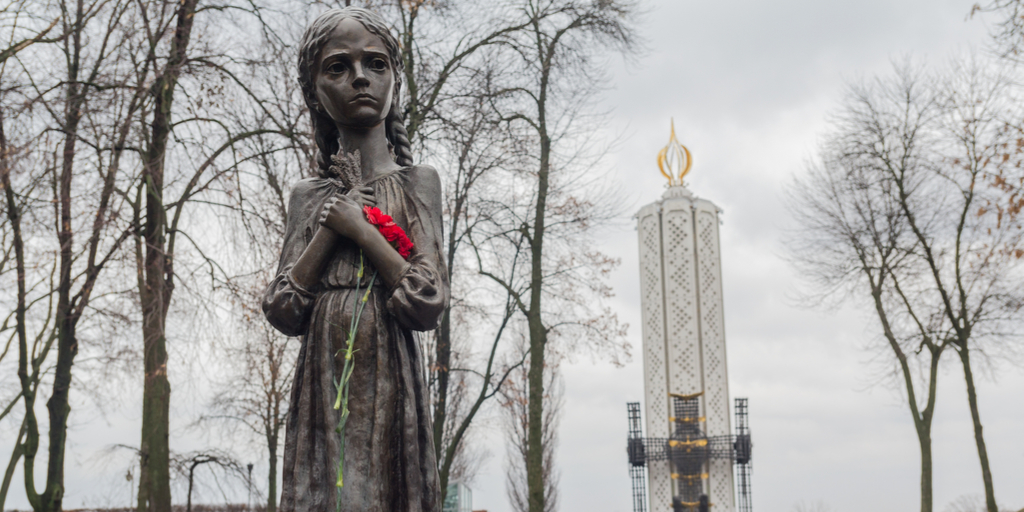Mr. Jones shows that a caricature of life, once enacted, turns deadly.
Thinking About the Holodomor: Part II
The Soviet attack on the reality of the Ukrainian Famine of 1932 and 1933 was coterminous with the Holodomor itself. As I pointed out in my first post, Red Famine author Anne Applebaum, and before her, the Hoover Institution scholar Robert Conquest, have emphasized the militancy and vast scale of this effort. According to Conquest one can break Soviet strategy down into two strategies: first, outright denial of the event; second, the spreading of ameliorating falsehoods, often with the assistance of key allies in the West.
The denial of the event of course began with ignoring it. The Holodomor was never spoken of by public figures, never mentioned in newspapers or any other Soviet publications, and official statistics, such as census figures, were altered. While it was going on, access to famine areas was severely restricted, as was travel from these areas by those trying to escape in search of food.
The Soviets went to great lengths to enforce this silence. Military conscript Ivan Shewchuk received a letter during the famine from his wife back home in a small Ukrainian village called Barashne. She spoke of everyone in the place being swollen with hunger, including their son. Ivan, reading the letter to his friends, was interrupted by the political instructor and called to the regimental office in Feodosiya. The following day he was forced to read a statement that said the letter had been written not by his wife but by class enemies intent on sowing distrust and disorder in the Red Army. Ivan’s wife and son did not survive.
The next stage was the dissemination of outright falsehoods. The international context made this even more important than routine propaganda efforts.
As Applebaum notes, although by 1933 world revolution had come to seem a rather distant hope, radical political transformation seemed plausible. There was an economic crisis in the Western democracies that assisted the rise of Adolf Hitler to the chancellorship of Germany. The rise of fascism, according to Soviet ideology, meant the onset of the final crisis of capitalism. Here was an opportunity to reassert the promise of the superiority of the Soviet system.
Moreover, the Union of Soviet Socialist Republics was on the verge of receiving official diplomatic recognition from the United States (extended by President Roosevelt in November 1933). So the Soviets used foreign visitors to spread the gospel of socialism abroad and buttress domestic support. Writers with international reputations like Anatole France and George Bernard Shaw were welcomed and feted—the latter spent his 75th birthday in Moscow in 1931.
During the summer of 1933, Edouard Herriot, a former French premier, visited Ukraine. The Soviets welcomed him expressly to refute rumors about the famine, while Herriot’s intentions seem to have been related to trade relations between his home country and the USSR. He visited a variety of Soviet institutions—all carefully refurbished before his visit and managed during it. After his two-week excursion, Herriot declared: “I’ve traveled across Ukraine. I assure you that I have seen a garden in full bloom.” According to Applebaum, OGPU (Soviet secret police) reports note that Herriot did ask about the famine, but that he seemed satisfied by assertions that shortages of food had been overcome.
A Welshman’s Sojourn
Contrast Herriot’s story with that of a young Welshman named Gareth Jones. A linguist fluent in Russian, French, and German, Jones (whose story will be the subject of a major feature film next year directed by Agnieszka Holland) signed on as a researcher for David Lloyd George, the Liberal Party statesman and former Prime Minister, shortly after taking his degree from Cambridge. As Andrew Stuttaford has noted, Jones was ripe for conversion to communism. He was “ornery, high-minded, pacifist, egalitarian, a touch goofy, [and] a little bit utopian.”
Jones first visited the Soviet Union on a tourist visa in 1930. Afterward the 25-year-old sent a note home to the United Kingdom from Berlin: “Russia is in a very bad state, rotten, no food, only bread; oppression, injustice . . . It makes me mad to think that people like [names crossed out] go there and come back, after having been led around by the nose and had enough to eat, and say that Russia is a paradise.” Thus Jones already had a sense of the inaccuracy of what was being written in the West about the USSR—where famine was in fact widespread. He was to witness much more devastating scenes three years later.
In the interim, Jones’s star rose quickly in the world of British journalism. He befriended other foreign correspondents and continued to gather information about what was happening in the Soviet Union. In early 1933, he planned a visit to Germany and the USSR. The Soviets were eager to cultivate this aide to Lloyd George, a significant player in British politics. The Soviet ambassador in London worked with colleagues back in Moscow to arrange Jones’s visit, which was to include stops in the Russian capital and also in Kharkiv, one of the larger cities in Ukraine.
Jones stayed in the USSR for about three weeks. His visit and the diaries he kept became the basis for 21 articles published in the spring of 1933. (Available here. They have been transcribed and published, and make fascinating reading.) While in Russia and Ukraine, he read newspapers, talked with Soviet officials and diplomats from many countries, gathered statistics, walked into shops and noted prices, and interacted with people he met on the street. In Moscow he was approached by beggars from Ukraine searching for food and was told, “The best people in Russia are in Solovki [a labor camp in northern Siberia].” He also heard the following joke:
When there is bread in the villages and no bread in the towns, that is a Right Wing Deviation. When there’s bread in the towns and no bread in the villages, that is a Left Wing Deviation. When there is no bread in the towns and no bread in the villages that’s the Party Line.
The contrast between what was said by officials and what people told Jones in private must have been shocking. If so, he kept his reactions to himself, for his real coup was his totally unsupervised trek through small Ukrianian villages in mid-March of 1933. He was invited to tour a tractor factory in Kharkiv as a guest of the German consulate there. He boarded an overnight train bound for Kharkiv but he got off about 70 kilometers from the city. Lodging with peasants in the villages, he saw the devastation first hand. Nothing could have prepared him for what he encountered. He was told by one woman: “We are looking forward to death.”
Jones held a press conference in Berlin on March 29 and revealed what he had seen and heard in Moscow and Ukraine—whereupon the Soviets acted swiftly and decisively, with all the tools of influence and propaganda at their disposal. The foreign correspondents working in Moscow were enlisted in an effort to undermine Jones’s reporting. Many denounced him, and none more shamefully than Walter Duranty of the New York Times.
In an article printed in that newspaper published on March 31, 1933, Duranty claimed Jones had only seen a small and insignificant portion of the Soviet Union, that any “food shortages” could be blamed on the “novelty” of collective farming and a conspiracy of enemies, and that Duranty himself had undertaken exhaustive research of his own with Soviet commissariats and foreign embassies. The latter enabled Duranty to assert, “There is no actual starvation or deaths from starvation, but there is widespread mortality from diseases due to malnutrition.” And the article included that infamous line, “You can’t make an omelet without breaking eggs,” likening the Soviet leaders’ situation to a general’s attitude toward his troops when he orders a costly attack.
Jones wrote a judicious, and what should have been devastating, letter to the Times defending himself and explaining his sources. But Duranty was a superstar of journalism and Jones a rather unknown Welshman. As Eugene Lyons, the United Press International correspondent in Moscow, would later admit in his memoir Assignment in Utopia (1938): “Throwing down Jones was as unpleasant a chore as fell to any of us in years of juggling facts to please dictatorial regimes—but throw him down we did, unanimously and in almost identical formulations of equivocation.”
It is a depressing spectacle. The accounts published by Gareth Jones (21 articles published between March 31 and April 30) and his fellow Briton, Malcolm Muggeridge (who wrote three unsigned articles for the Manchester Guardian published on March 25, 27, and 28, recapping his visit to the USSR that took place months before Jones’s) did reach Western audiences and provide a vivid and accurate picture of the famine. As Conquest writes: “This lobby of the blind and the blindfold could not actually prevent true accounts by those who were neither dupes nor liars from reaching the West. But they could, and did, succeed in giving the impression that there was at least genuine doubt about what was happening and insinuating that reports of starvation came only from those hostile to the Soviet government and hence of dubious reliability.”
These falsifications then entered academic scholarship (through such prominent figures as Beatrice and Sydney Webb) and even popular culture, for instance in the grotesque Hollywood film North Star (1940), a portrayal of the wonders of Soviet collective farming.
Applebaum’s chapter called “The Holodomor in History and Memory” is instructive here. She explains that firsthand accounts of the famine from Ukrainians themselves started to emerge in the postwar period from Ukrainian émigrés who had managed to escape to Canada. Though dismissed by the Sovietologists in the West as “period pieces,” these accounts are absolutely essential to a proper understanding of what happened in Ukraine in the late 1920s and early 1930s.
In this regard, Olexa Woropay’s The Ninth Circle (published in London in the late 1940s and in the United States in 1983) and Semen Pidhainy’s collection The Black Deeds of the Kremlin (1953) both deserve a wide audience. They are eyewitness accounts of the atrocities, and they were ignored by academic historians for many years. Not until the collapse of the Soviet Union would such authors begin to be given a fair hearing rather than disdained for their alleged Cold Warrior bias.



